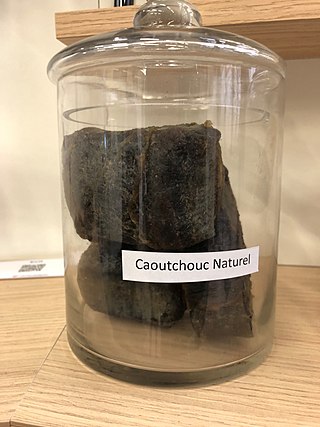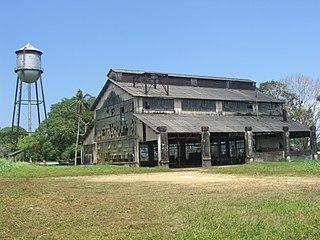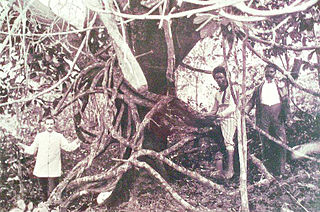Related Research Articles

Rubber, also called India rubber, latex, Amazonian rubber, caucho, or caoutchouc, as initially produced, consists of polymers of the organic compound isoprene, with minor impurities of other organic compounds. Thailand, Malaysia, Indonesia, and Cambodia are four of the leading rubber producers.

Francisco Alves Mendes Filho, better known as Chico Mendes, was a Brazilian rubber tapper, trade union leader and environmentalist. He fought to preserve the Amazon rainforest, and advocated for the human rights of Brazilian peasants and Indigenous peoples. He was assassinated by a rancher on 22 December 1988. The Chico Mendes Institute for Biodiversity Conservation, a body under the jurisdiction of the Brazilian Ministry of the Environment, is named in his honor.

A rubber band is a loop of rubber, usually ring or oval shaped, and commonly used to hold multiple objects together. The rubber band was patented in England on March 17, 1845, by Stephen Perry. Most rubber bands are manufactured out of natural rubber as well as for latex free rubber bands or, especially at larger sizes, an elastomer, and are sold in a variety of sizes.

Fordlândia is a district and adjacent area of 14,268 square kilometres (5,509 sq mi) in the city of Aveiro, in the Brazilian state of Pará. It is located on the east banks of the Tapajós river roughly 300 kilometres (190 mi) south of the city of Santarém.

Hevea brasiliensis, the Pará rubber tree, sharinga tree, seringueira, or most commonly, rubber tree or rubber plant, is a flowering plant belonging to the spurge family Euphorbiaceae originally native to the Amazon basin, but is now pantropical in distribution due to introductions. It is the most economically important member of the genus Hevea because the milky latex extracted from the tree is the primary source of natural rubber.

Manilkara bidentata is a species of Manilkara native to a large area of northern South America, Central America and the Caribbean. Common names include bulletwood, balatá, ausubo, massaranduba, quinilla, and (ambiguously) "cow-tree".

Parthenium argentatum, commonly known as the guayule, is a perennial woody shrub in the family Asteraceae that is native to the rangeland area of the Chihuahuan Desert; including the southwestern United States and northern Mexico. It was first documented by J.M. Bigelow in 1852 through the Mexican Boundary Survey and was first described by Asa Gray. Natural rubber, ethanol, non-toxic adhesives, and other specialty chemicals can be extracted from guayule. An alternative source of latex that is hypoallergenic, unlike the normal Hevea rubber, can also be extracted. While Castilla elastica was the most widely used rubber source of Mesoamericans in pre-Columbian times, guayule was also used, though less frequently. The name "guayule" derives from the Nahuatl word ulli/olli, "rubber".

Sir Henry Alexander Wickham was a British explorer. He was the first person to successfully export a large, viable shipment of, smuggled, Brazilian rubber seeds to the British Empire. The British had long planned to create rubber plantations in Southeast Asia, and using Wickham's batch, the resulting plantations brought about the end of the Amazon rubber boom.

Gamboge is a deep yellow pigment derived from a species of tree that primarily grows in Cambodia. Popular in east Asian watercolor works, it has been used across a number of media dating back to the 8th century. Easy to transport and manipulate into a durable watercolor paint, gamboge is notable for its versatility as a pigment in how it has been used in paintings, printing of books, and garment dyes, including the robes of Buddhist monks. Though used in a number of different contexts, Gamboge is known not to react well with lime surfaces therefore making it unsuitable for frescos and with white lead. For its popularity, Gamboge has not been extensively identified in works of art from any time period; the few instances wherein art historians have attempted to identify whether or not the pigment was used in a given work have confirmed its widespread use and its longevity as staple within watercolor painting particularly in eastern art.

Ficus elastica, the rubber fig, rubber bush, rubber tree, rubber plant, or Indian rubber bush, Indian rubber tree, is a species of flowering plant in the family Moraceae, native to eastern parts of South and Southeast Asia. It has become naturalized in Sri Lanka, the West Indies, and the US state of Florida. Despite its common names, it is not used in the commercial production of natural rubber.

The naval stores industry produces and markets products derived from the oleoresin of pine trees, including rosin, tall oil, pine oil, and turpentine. It does this by collecting and processing organic forest products refined from slash pine and longleaf pine trees. The naval stores industry was associated with the maintenance of the wooden ships and sailing tackle of pre-20th century navies, which were caulked and waterproofed using the pitch of the pine tree.

Rubber tapping is the process by which latex is collected from a rubber tree. The latex is harvested by slicing a groove into the bark of the tree at a depth of one-quarter inch (6.4 mm) with a hooked knife and peeling back the bark. Trees must be approximately six years old and six inches (150 mm) in diameter in order to be tapped for latex.

Castilla is a genus of 3 species of large trees in the family Moraceae, native to Central and South America.

The Amazon rubber cycle or boom was an important part of the economic and social history of Brazil and Amazonian regions of neighboring countries, being related to the extraction and commercialization of rubber. Centered in the Amazon Basin, the boom resulted in a large expansion of colonization in the area, attracting immigrant workers, generating wealth, causing cultural and social transformations, and disrupting local indigenous societies.

Latex is an emulsion of polymer microparticles in water. Latexes are found in nature, but synthetic latexes are common as well.
Vytex Natural Rubber Latex (NRL) is a brand of natural rubber latex produced and marketed by Vystar Corporation. Vytex NRL is an alternative material to petroleum-based synthetics and traditional (Hevea) natural rubber latex. Protein test results show that Vytex NRL typically has 90% fewer antigenic proteins than Hevea natural rubber latex.

Hydrocarbon plants are plants that follow certain metabolic pathways that produce hydrocarbon products similar to petroleum. These hydrocarbon products are called terpenoids. The plants that produce terpenoids in large enough quantities to be harvested can be as big as trees or as small as single-cell algae. The family Euphorbiaceae has been studied in detail by Dr. Melvin Calvin, Nobel Laureate, and discoverer of the Calvin Cycle. One particular tree of the genus Hevea, more commonly known as the rubber tree, is probably the most famous hydrocarbon plant, supplying an estimated one third of the world’s rubber demand. It is still not as quick and cheap to make as petroleum-based rubber, which is why it does not occupy a larger portion of the market. Hevea naturally produces a latex substance which can tapped by cutting into the tree, and the latex can then be processed into rubber.
Chico Mendes Extractive Reserve is an extractive reserve in the state of Acre, Brazil.

Aquariquara Extractive Reserve is an extractive reserve in the state of Rondônia, Brazil. The main source of income for the residents is sale of latex (rubber) extracted using traditional methods. Lumber is also extracted on a sustainable basis, but many residents receive little or no compensation. Given the very low income from extraction, residents may turn to illegal logging, farming and livestock husbandry.

Landolphia owariensis is a species of liana from the family Apocynaceae found in tropical Africa. Latex can be extracted from this plant for the manufacture of natural rubber. Other names for this vine are eta, the white rubber vine and the Congo rubber plant. Congo rubber was a commercial rubber exported from the Congo Free State starting in 1890, most notable for its forced harvesting under conditions of great human suffering, in the Congo Free State, detailed in the 1904 Casement Report. From 1885 to 1908, millions died as a result of murder, deprivation, and disease, with population falling by millions in this period; some writers estimate this loss to be as high as 10 million people.
References
- Hobhouse, Henry (2003, 2005). Seeds of Wealth: Five Plants That Made Men Rich. Shoemaker & Hoard. pp. 141–142. ISBN 1-59376-089-2.